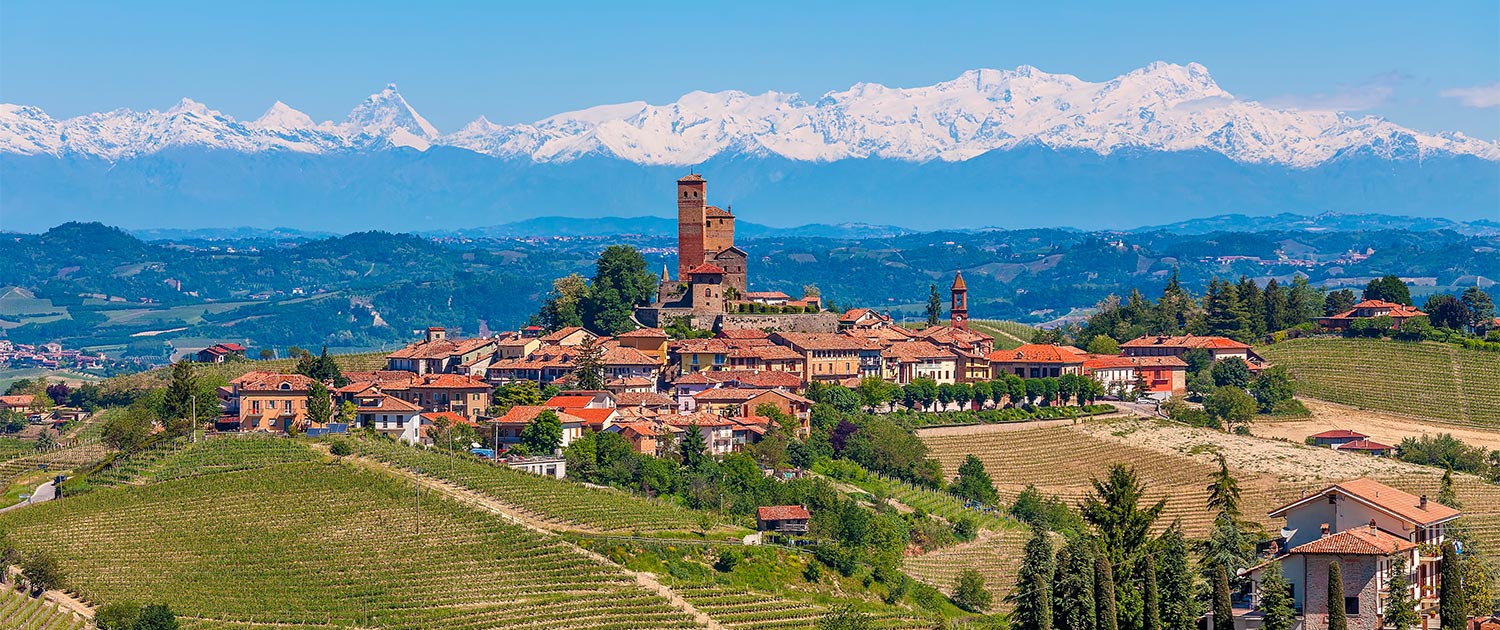
Yet in many respects, the wines of this stunning region, tucked into the north-west corner of the peninsula, have more in common with those across the Alps in France or Switzerland than they do with Puglia or Sicilia. Turin is closer to London than it is to Palermo, after all.
Surrounded on three sides by mountains and on its fourth by major rivers, Piedmont enjoys the natural attributes of a protected enclave and has held onto so much of its distinctive culture as a result. As part of the House of Savoy, which became the Kingdom of Sardinia, the precursor of the Kingdom of Italy, it has been a powerful and prosperous regional player. Turin, capital of Savoy since the 16th century, briefly became the capital of Italy. Camillo Benzo, the count of Cavour, was not only one of the key figures in unification but was a committed vinegrower. At his estate in Grinzane, he hired Louis Oudart, the French oenologist credited with cracking the code of how to make dry, still wines from the local grapes. Cavour and Oudart’s successes attracted the attention of the royal family, who followed suit at their estates in Verduno, Roddi and Serralunga ultimately giving rise to Barolo’s claim to be the ‘wine of Kings and the King of wines’.
Barolo and its neighbour, Barbaresco rightly enjoy their status as leading lights but as they account for roughly 2700 ha out of the Piedmont’s estimated 70,000 ha of vineyard, it would be disrespectful to ignore the other 96%. More than half of these are also designated at the top DOC or DOCG level and include familiar names such as Asti, Alessandria and the resurgent Alto Piemonte. All share in the rich viticultural heritage of the region, particularly its indigenous grape varieties.
Nebbiolo is the distinctive red grape of Piedmont, as important here as Pinot Noir is to Burgundy. That is not to downplay the supporting cast- Barbera, Dolcetto, Freisa, Grignolino, Brachetto, Ruchè and the rest- but Nebbiolo in all of its complex glories is the draw card, uniquely suited to the hills of the region where it is able to ripen late, often surrounded by the autumnal fogs (nebbia) which give it its name.
White grapes are very much in the minority, with Moscato, Erbaluce, Cortese, Arneis, Favorita (Vermentino), Timorasso and Nascetta being the most important. Historically, sweet and sparkling styles were favoured but today sees the advance of still and dry styles, particularly as the region has modernised and embraced techniques such as temperature control. International varieties have arrived in both colours but, aside from some notable exceptions, have made relatively little headway.
The hills that surround Alba on the right bank of the River Tanaro are known as the Langhe, while on the left bank is Roero, a separate appellation. The lighter, sandier soils of Roero are an important source for Nebbiolo d’Alba which alongside Langhe Nebbiolo is becoming an increasingly interesting appellation for earlier drinking Nebbiolo at more affordable levels.
Hillsides in Piedmont offer exposures to all points of the compass and a great variety of microclimates. The classical pattern has been for Nebbiolo to be planted on those with southerly exposures, known in the local dialect as a sorì. The north sides were more suitable for the early-ripening Dolcetto and Moscato which with their short vinifications, could be processed before the Nebbiolo came in.
Barolo as a name only really started to appear in the mid 19th century, aligning closely to the movement of Risorgimento. Previously these were local wines sold in cask, largely unlabelled and the style would have been slightly sweet and sparkling, not dissimilar to Lambrusco. The official ‘Barolo zone’ divides between nine subdistricts of which there are five core ones- La Morra, Castiglione Falletto, Serralunga d’Alba, Montforte d’Alba and Barolo itself. Barolo and La Morra are on lighter, calcareous Tortonian soils, the other three on poorer compressed sandstone Helvetian soils.
Historically this was an area of tiny subsistence farmers who sold grapes in the market place. Even in 2010, there were almost 1000 growers within Barolo’s 2000 ha. As a result, estate bottling was seldom seen until the 1960s and there is still a debate today between those who believe that a blend offers far more than a single site expression. The concept of a ‘cru’ has further muddied the waters: there is no formal classification as in Burgundy but more a zonal demarcation, with over 170 sites, some as large in size as 300ha. In such a situation, buying according to the reputation of the grower remains the simplest advice.
Barbaresco, enjoying neither regal favour nor a bridge over the Tanaro, has only recently stepped out of the shadows of Barolo. With around 700ha of vineyards over the communes of Neive, Treiso and Barbaresco itself, Nebbiolo tends to ripen earlier here than in the Barolo zone thanks to the softening influence of the Tanaro. As a result, it is not required to age as long in cellar as its neighbour. The notion of a ‘cru’ is even less official here than in Barolo, stemming simply from the historic pricing of certain favoured sites.
The rise of Barolo and Barbaresco since the 1960s has not been without incident. The ‘style battles’ of the 1980s and 1990s were a response to changing consumer tastes and demands, particularly as the wines gained an international audience. Thankfully, that pendulum has largely settled today. The top growers are focussed on their vineyards, with sustainable farming, minimal intervention, biodynamics and water shortage being the topics of the day. On the international stage, the region enjoys prestige as never before, lining up alongside the greatest names of the wine world and speaking in a confident, proud and distinctively Piedmontese voice.